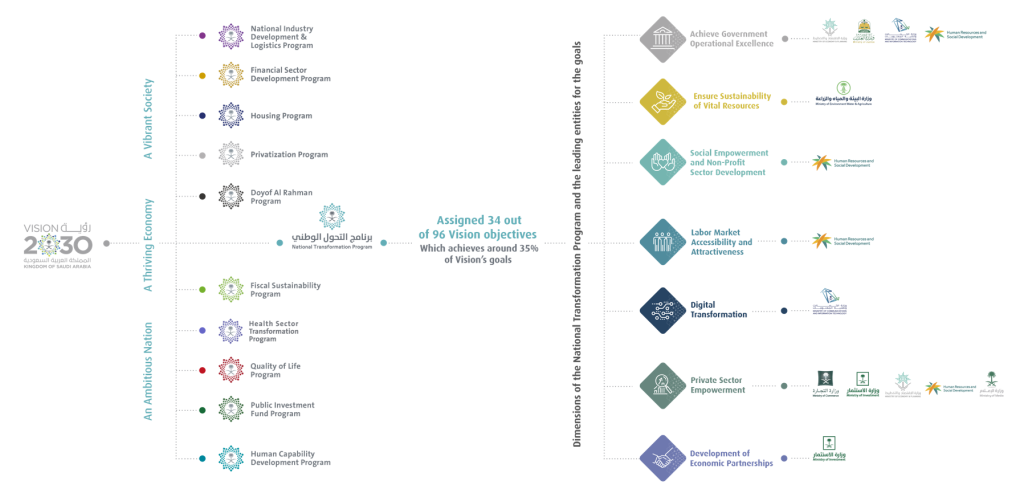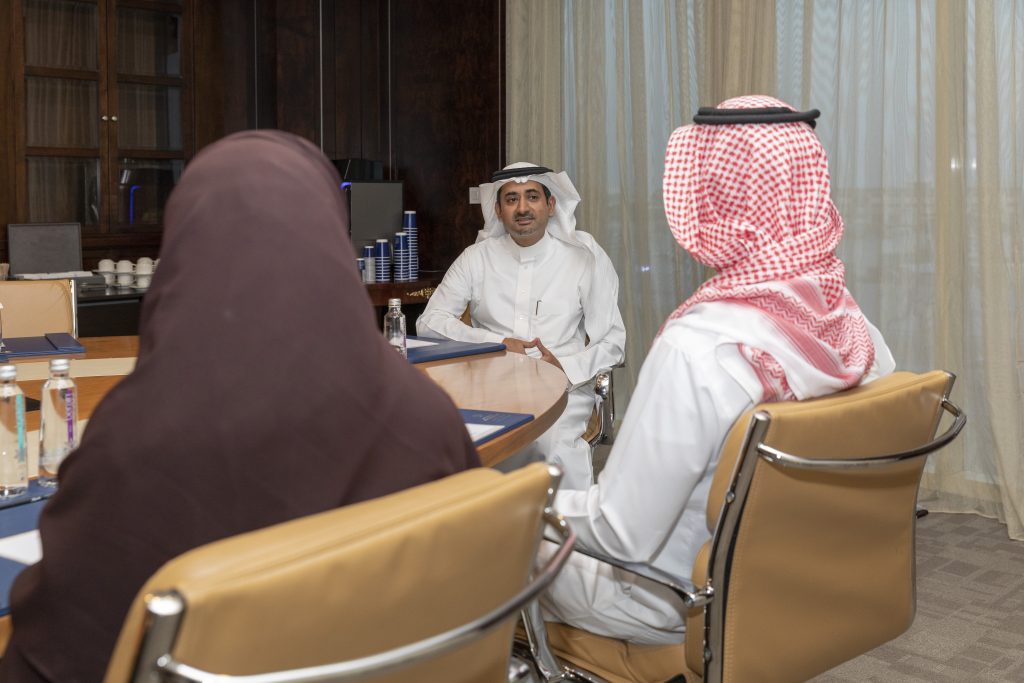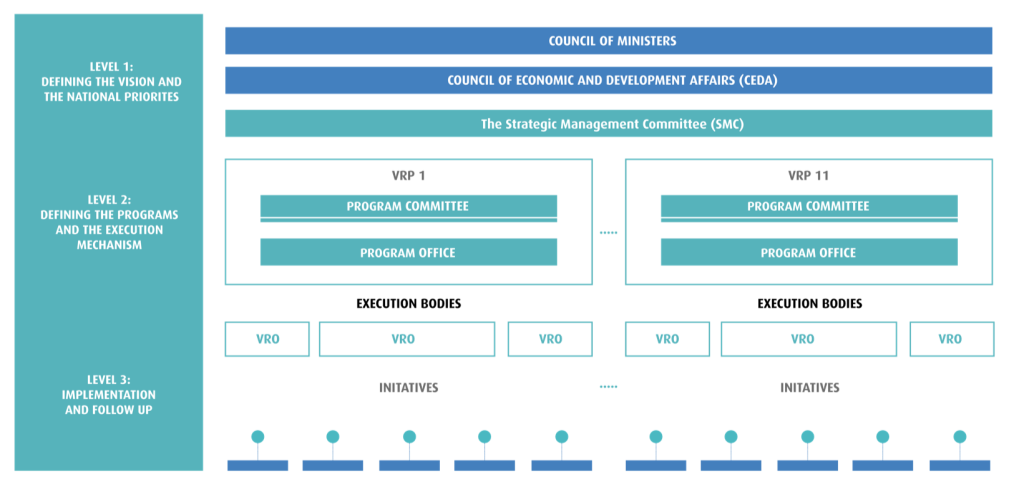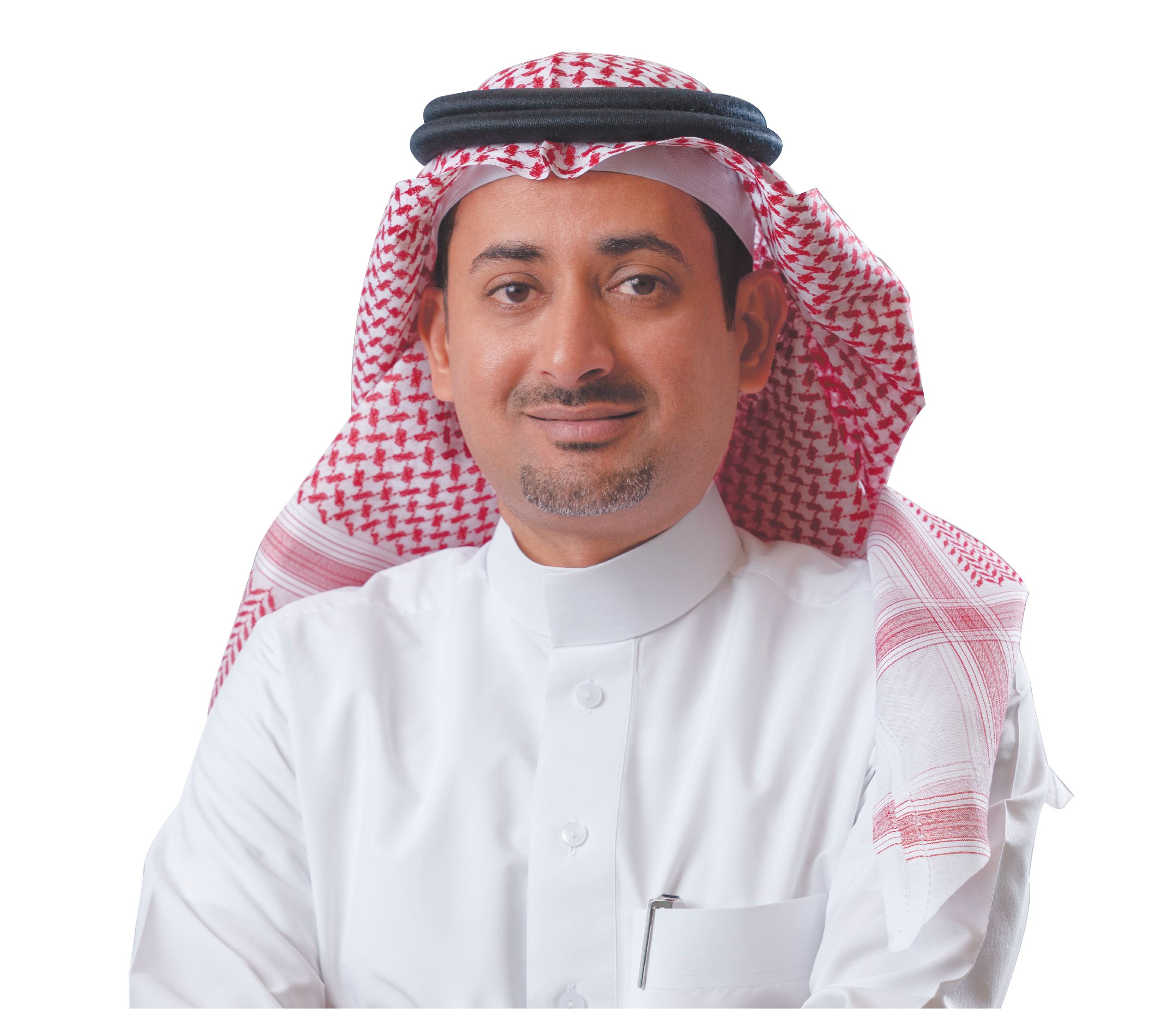As the Kingdom takes bold steps towards the fulfillment of its ambitious Vision 2030, several Vision Realization Programs (VRPs) have been instated to realize the wide-arching strategic objectives under the Vision. Each of these programs has an actionable roadmap, delivery plans, and key performance indicators to track the Kingdom’s progress along this transformative journey.
The National Transformation Program (NTP) is one of the most prominent of the VRPs. It is a cornerstone of the Vision 2030 and is responsible for 35% of strategic objectives under the Vision – the most out of all VRPs. Its mandate includes the digitalization of government services, fostering diversity and inclusivity in the private sector, and the creation of a diversified, innovative, and globally pioneering nation, impacting virtually every sector of Saudi society.
As we reach the halfway mark of the Vision, the SandRose Magazine team sat down with Mr. Thamir Alsadoun, CEO of the National Transformation Program, to reflect on the milestones of this program as well as the exciting changes that lie ahead. At the helm of this bold program, Mr. Alsadoun’s leadership and insights are crucial to navigating the complexities of this unprecedented national endeavor.

The Vision Realization Programs (VROs) and the dimensions of the National Transformation Program
What can you tell us about the NTP and how it contributes to Saudi Vision 2030’s success?
The National Transformation Program (NTP) is a Vision Realization Program (VRP) that aims to develop the necessary infrastructure and create an environment that enables the public, private, and non-profit sectors to deliver Vision 2030. Under Vision 2030, there are 11 VRPs. NTP was launched in 2016 as the first VRP and is currently responsible for achieving 35% of Vision 2030’s strategic objectives. NTP contributes to the Vision’s success by achieving government operational excellence, supporting digital transformation, enabling the private sector, developing economic partnerships, promoting social development, and ensuring the sustainability of vital resources.

Quick facts about the National Transformation Program (NTP)

Mr. Thamir Alsadoun delves into the inner workings of the NTP with the SandRose Magazine team
What are the primary enablers of success in the process of translating an ambitious strategy to actual realized impact on the ground?
Developing the appropriate strategy starts with conducting a gap analysis to understand what needs to be accomplished, translating it into actions and projects that will bridge the identified gaps, and selecting the right indicators that will work as a system to monitor the execution of the strategy and measure its progress towards achieving the organization’s objectives.
Successful implementation is crucial in ensuring results are achieved and impact is realized. To translate ambition into actual impact, there are a few primary enablers. First, leadership plays a key role in defining and clearly communicating the organization’s priorities and strategic objectives to all levels and setting a suitable governance model to support and direct the organization’s resources in achieving these objectives.
Second, having the right people in the right place is important. It is imperative to attract, develop, and retain the required talent, create an attractive work environment, and align the incentives scheme with the organization’s priorities.
Third, is managing strategic partnerships with key stakeholders and ensuring alignment. Lastly, the right processes should be designed to enable the desired outcome and to be agile enough to continuously improve and achieve better results.
As the Kingdom reaches the halfway mark of Vision 2030, what have been the major accomplishments that have been realized at this milestone?
There have been many monumental achievements in the Kingdom due to Vision 2030. Regarding the Kingdom’s digitization efforts, over 6,000 e-government services are now offered digitally, representing over 97% of total government services. Over 95% of litigation sessions are now conducted online, which has led to a 79% decrease in case duration to ensure that these services are accessible to all beneficiaries. In addition to that, broadband coverage is now available in 99% of the Kingdom, and 97 provinces have 5G services. This led to Saudi Arabia achieving the highest result in the UN’s E-Government Development Index (EGDI) as it advanced 12 ranks globally.
“ This led to Saudi Arabia achieving the highest result in the UN’s E-Government Development Index (EGDI) as it advanced 12 ranks globally. ”
The attractiveness of investing in Saudi Arabia is not just a claim, but a reality. The rapid growth of foreign investment is a testament to this. More than 400 global companies have obtained permits to open regional offices in the Kingdom, underscoring its status as a desirable investment destination.
In 2023, foreign investment licenses grew by more than 96% compared to 2022, and 22 times since the start of Vision 2030. This growth is a clear indication of the confidence that global investors have in the Kingdom’s potential. This is just a fraction of what has been achieved, and our ambition is greater still. I encourage the readers to take a look at the NTP annual report which is published on the Vision 2030 website.
“ In 2023, foreign investment licenses grew by more than 96% compared to 2022, and 22 times since the start of Vision 2030. ”

Some of the key milestones across the NTP journey from 2016 – 2023
How does the NTP enable the growth of the non-profit sector in general and volunteerism in particular within the Kingdom?
Saudi Vision 2030 has set 3 strategic objectives assigned to the NTP to transform the non-profit sector into a major contributor to the development of the Kingdom socially and economically.
Several initiatives are being executed under these strategic objectives, including, but not limited to, establishing the regulatory framework of the non-profit sector, providing financial support and incentives, and promoting the sector through public awareness and campaigns.
One of NTP’s major achievements in 2019 was the establishment of the National Center for Non-Profit Sector, which aims to develop a strong and sustainable non-profit sector with a profound impact.
Through the implementation of these initiatives and strategic objectives, NTP has cultivated a nurturing environment for the non-profit sector to flourish. This has led to significant growth, with the number of non-profit organizations surging by over 200% by mid of this year compared to the baseline. Moreover, the workforce in the non-profit sector has seen a substantial increase, from 19,000 in 2017 to over 80,000 by the end of 2023.
As for volunteering, Vision 2030’s target is to reach 1 million annual volunteers by 2030. Thus, NTP launched several initiatives to encourage volunteering. Most importantly, these initiatives include approving the Voluntary Service Law and launching the National Volunteer Portal to preserve the volunteers’ rights and make it easier to find volunteering opportunities. In 2016, we started with 34 thousand annual volunteers; in 2023, we reached over 834 thousand.
What strategies are being employed to increase Saudi women’s participation in the workforce?
NTP’s commitment to increasing women’s participation in the workforce is evident in the implementation of several initiatives. Notably, significant policy reforms, such as labor market reforms, have been introduced to foster gender equality in the workplace. These reforms include equal pay and maternity leave policies, ensuring a fair and supportive environment for all employees. Additionally, measures have been taken to equip women with the necessary skills for the labor market, and ‘remote’ and ‘flexible work’ options have been introduced to enhance labor market accessibility.
NTP’s initiatives to support women in the workforce extend beyond policy reforms. The introduction of cultural and social changes has played a significant role. The ‘Wusool’ transport support program has made commuting to work easier for women, while the ‘Qurrah’ childcare for working women program has provided crucial support for working mothers. Lastly, training and development initiatives were part of NTP’s strategy to upskill Saudi women for various work opportunities. In addition to that, leadership programs were introduced to enable women to pursue leadership positions.
These initiatives have led to significant progress in increasing women’s participation in the workforce to more than 34% by Q1 2024, exceeding Vision 2030’s target of 30%. Furthermore, the women’s ratio in managerial positions exceeded 43% in Q1 2024, compared to 28% in 2017.
“ These initiatives have led to significant progress in increasing women’s participation in the workforce to more than 34% by Q1 2024, exceeding Vision 2030’s target of 30%. ”
What are some of the programs and initiatives enabling the success of entrepreneurship in the Kingdom?
Significant efforts have been made to empower the private sector and enable entrepreneurs. The establishment of the Saudi Business Center, a one-stop-shop for all major government stakeholders, has significantly streamlined the process of starting and running a business. This is evidenced by the reduction in the time to start a business from 15 days to just 30 minutes. More than 750 economic reforms have been implemented to support this initiative.
To support small-to-medium enterprises (SMEs) with their financing challenges, the SME Bank was established, a secure source of financial support providing over 29 billion SAR in funding since its launch. The Center of Digital Entrepreneurship (CODE) was launched to support digital entrepreneurship, helping to launch almost 800 startups and create over 2 thousand jobs.
The ‘Tomoh’ program was launched to take high-performing small companies and provide them with the tools and support necessary to grow into medium-sized companies and beyond. Over 3,500 companies have graduated from the program, with many now listed. These initiatives have led to a 200% growth in the number of SMEs, reaching over 1.3 million.
Considering the vast scope of Saudi Vision 2030, what have been some of the main challenges? And how were you able to overcome them?
Vision 2030 is a very ambitious roadmap that leverages the Kingdom’s unique strengths. It is a blueprint for diversifying the economy, empowering citizens, creating a vibrant environment for local and international investors, and establishing Saudi Arabia as a global leader. At NTP, we are proud to have been part of this promising journey from the start. We definitely faced challenges that we overcame with tremendous leadership support.
One challenge is ensuring alignment across different government agencies. Considering the scale and complexity of NTP, coordinating the alignment of various government ministries and agencies proved challenging. To address this, Vision Realization Offices (VROs) were established within each ministry. These units fostered collaboration and coordination, allowing for joint initiatives, progress tracking, and a unified focus.
Another challenge is capability building. We recognized the need for a diverse talent pool to address all aspects of the program. To ensure successful program implementation, we strategically sought top talent, invested in capacity-building programs, and implemented robust project management frameworks.
Last but not least, accurate and timely data are essential for tracking progress and for effective decision-making. Therefore, the government established the National Center for Performance Measurement (Adaa) to improve data collection, analysis, and reporting. Adaa has been instrumental in enhancing data quality and ensuring its practical use for informing policy decisions and tracking progress.

The governance structure of the Vision 2030 including the Vision Realization Programs (VROs)
Given your extensive experience at Aramco in managing large-scale infrastructure projects, what lessons have you applied in your transition to broader national-level reforms under NTP?
I joined Saudi Aramco immediately after high school and stayed with the company for 20 years. Saudi Aramco sponsored me to study for bachelor’s and master’s degrees in addition to the opportunities to work on large-scale projects, including overseeing assignments with leading engineering and architecture firms. Saudi Aramco is like a university where you continue to learn and grow. I take pride in the time I worked for Saudi Aramco and am grateful for the opportunities it provided me.
At Saudi Aramco, aligning each project with the company’s strategic goals was not just a task but a critical aspect of our work. This involved thorough planning and clear objectives. Similarly, in national reforms, ensuring that every initiative aligns with the broader goals of Vision 2030 is vital. This approach ensures that resources and efforts are focused on areas that will have the most significant impact, driving the country toward its long-term vision.
Successful projects, both at Saudi Aramco and in national reforms, require close collaboration with various stakeholders, from government entities to international partners. This experience has been crucial in building consensus and ensuring all stakeholders are engaged and aligned. The power of effective communication in articulating the benefits and objectives of reforms cannot be overstated. It has been a key tool in gaining broad support and driving successful implementation.
Beyond that, regular monitoring and evaluation were key practices in Saudi Aramco to keep projects on track and deliver the desired results, identify potential risks early, develop mitigation plans, and respond quickly to challenges. This approach is equally vital in national reforms, where ongoing monitoring helps track progress, identify areas of improvement, ensure reforms deliver tangible benefits to society, and have robust risk management in place. Real-time adjustments based on evaluation feedback are essential for maintaining momentum and achieving the program’s goals.
More information about the Vision 2030 and the National Transformation Program can be found at the resources below:


